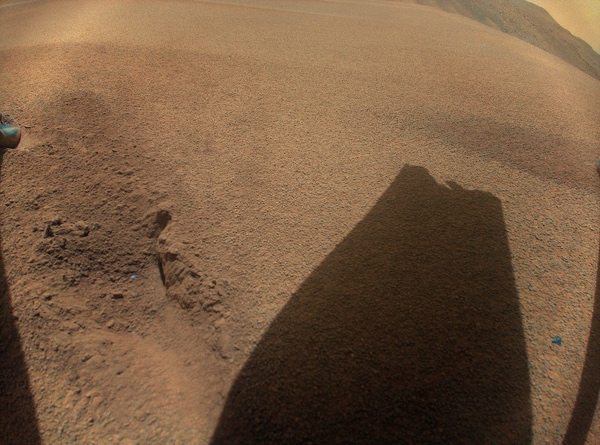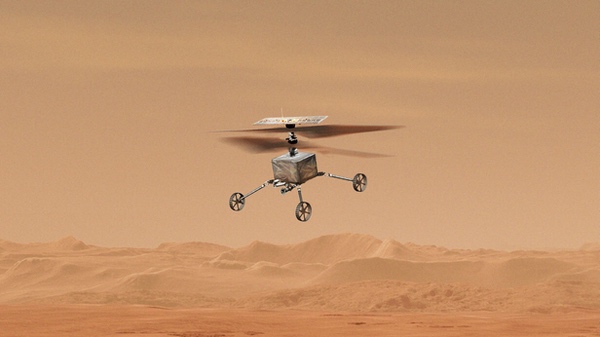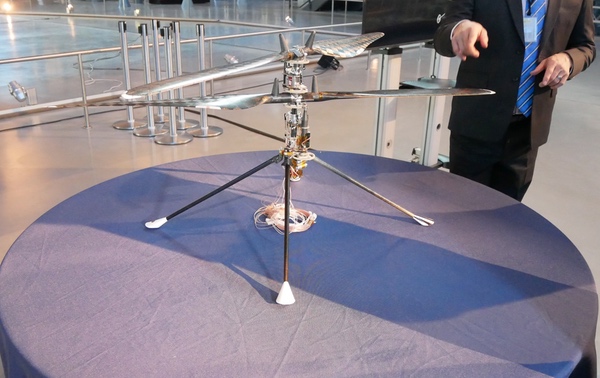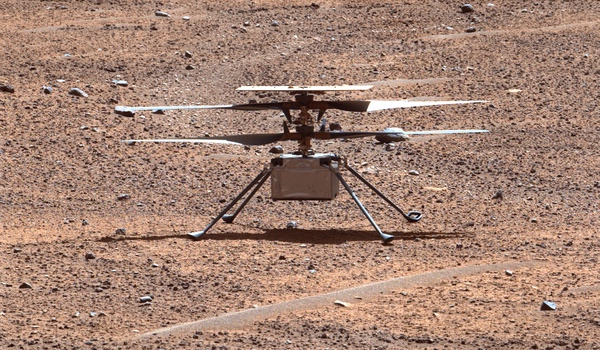The ingenuity of technology demosby Jeff Foust
|
| “The minute I heard there was going to be a helicopter on board the Perseverance mission I started talking to folks at JPL, asking, ‘Well, what else did you build along the way that maybe you could give to the Smithsonian?’” recalled Shindell. |
Those discussions led to the donation of the prototype, which was used in ground tests in a chamber that simulated Martian atmospheric conditions. That prototype, he noted, represented both Ingenuity itself as well as “the work that had to be done along the way to produce something like Ingenuity that does something new for the first time on another world.”
That interest, of course, only grew once Ingenuity started flying on Mars. “It has greatly exceeded our wildest dreams for the capabilities of this aircraft,” said Eric Ianson, director of the Mars Exploration Program at NASA headquarters. Expected to perform no more than five flights on Mars in April 2021, the helicopter made its 68th flight the day of the donation ceremony.
“The longevity of Ingenuity’s flight operations remains to be seen. We know it will eventually wrap up its mission,” he said. “In the meantime, the project team continues to push the envelope to further understand the capabilities and limitations of the system. Every day on Mars is a gift, and we're looking to make the most of the remaining opportunities.”
Teddy Tzanetos, Ingenuity project manager at JPL, echoed those comments, noting that every flight since the first “has been a gift—sprinkles on top of that original technology demonstration goal of proving that flight was possible.”
But that gift has come to an end. A little more than a month after that ceremony, NASA announced that Ingenuity had made its last flight, suffering damage from a hard landing that would keep it grounded. The success of Ingenuity, though, not only demonstrated the capabilities of powered flight on Mars but also the value of technology demonstrations despite, or perhaps even because, of a constrained NASA budget.
 An image returned by Ingenuity after its January 18 flight showed damage to one ofs rotor blades, visible in the shadow the rotor cast. (credit: NASA/JPL-Caltech) |
Bittersweet end
The first hint of a problem with Ingenuity came on January 19, when JPL announced that it had lost contact with the helicopter during its latest flight, its 72nd. While that sparked initial alarm, a day later JPL said it has restored contact. It seemed like just a glitch, similar to those that temporarily paused flights in the past.
On Thursday, though, the bad news came. “It is bittersweet that I must announce that Ingenuity, the little helicopter that could,” NASA administrator Bill Nelson said in a video message, “has now taken its last flight on Mars.”
| “There was the initial moment, obviously, of sadness,” Tzanetos said. “That’s very quickly replaced with happiness and pride and a feeling of celebration for what we’ve pulled off.” |
The project reached that conclusion, Tzanetos said in a call with reporters later that day, based on an image from the helicopter returned after landing. It showed a shadow of one of Ingenuity’s rotor blades, with a chunk missing from the end, presumably damage from contacting the ground. He estimated that about 25% of the end of that blade was missing. Since most of the lift from the blades comes from that outer portion, the loss of it meant that the helicopter could not fly again.
He added that the high speed of the rotors — about 2,500 rpm — meant that it was likely other blades were also damaged; engineers had not yet received images to confirm that. Even if not, having a portion of one blade mission would make Ingenuity unbalanced. “It must be perfectly balanced or any rotor system will shake itself apart.”
The flight was intended to be a simple up-and-down flight after the previous flight, January 6, ended in what the project called an “emergency landing.” The intent was to pop up and see where exactly the helicopter landed in order to plan future flights. The helicopter rose to its planned altitude of 12 meters and hovered for 4.5 seconds before descending. The loss of communications occurred when Ingenuity was a meter above the ground.
“Whether or not the blade strike occurred, which led to the communications loss, or there was a communications loss and a power brownout which then led to the rotor strike, we will never know,” Tzanetos said, because of a loss of data during the incident. The project team, though, was working to try and piece together what might have happened.
A key factor may have been the terrain that Ingenuity was flying over, which was featureless. That, counterintuitively, may have put the helicopter in jeopardy by confusing its navigation system.
“Any system where you track features in order to navigate is going to see a lot of different features, and some of them are going to be good features and some of them are going to be bad features,” explained Håvard Grip, the “pilot emeritus” for Ingenuity, on the call. “The way a system like this works is by looking at the consensus of what it sees and throwing out the things that don’t agree with the consensus.”
That doesn’t work well, though, when flying over terrain with few features. “The danger is when you run out of features, you don’t have very many to navigate on. You’re not able to establish what that consensus is, and you end up tracking the wrong kinds of features,” he said.
If that occurred, Ingenuity might overcorrect while trying to land when its navigation system was confused by spurious features. “It’s likely it made an aggressive maneuver to try and correct that upon landing, and that would have accounted for sideways motion and tilted the helicopter,” Grip said, either causing the rotor to hit the ground or a loss of power before landing.
There is no sign of other damage to Ingenuity other than the rotor, Tzanetos said. Ingenuity remains in contact with controllers via the Perseverance rover and will remain so until Perseverance moves out of communications range at some point in the coming weeks as it climbs out of Jezero Crater. The rover might be able to take some images of the helicopter, but is not expected to get closer than a couple hundred meters to Ingenuity before heading on its way.
| “It’s almost an understatement to say that it has surpassed expectations,” said Glaze. |
Ingenuity, having long exceeded its original five-flight mission, had been repurposed into an aerial scout for Perseverance. On one flight, Tzanetos said, the helicopter took images that scientists used to create a three-dimensional map. On other flights, Ingenuity flew ahead of Perseverance to examine the path the rover was supposed to take. “Rover planners could look at it early before Perseverance got there and try to assess if path A is safe or should we go down path B.”
But, he added, Ingenuity was not critical to Perseverance. “There won’t be a change to the Perseverance mission,” he said. “There was no part of Perseverance’s core science mission objectives that were dependent on Ingenuity at all.”
Because of that, the mood among both the project and other NASA officials was less somber than one might think. “Definitely bittersweet, but mostly incredibly celebratory,” said Laurie Leshin, director of JPL.
“It’s bittersweet for a moment there,” Tzanetos said. For the last two and a half years, “there’s always that piece in the back of your head getting ready, every downlink, that today could be the last day.”
“There was the initial moment, obviously, of sadness,” he said, when the image of the broken rotor came down from Mars. “That’s very quickly replaced with happiness and pride and a feeling of celebration for what we’ve pulled off.”
 A version of Ingenuity designed to pick up sample tubes for Mars Sample Return is under development. (credit: NASA/JPL-Caltech) |
The future of flight on Mars
Before Ingenuity made its first flight in April 2021, there was skepticism that it would work at all. There was debate about including it on Perseverance; some scientists involved on the mission worried that the unproven technology demo would, at a minimum, be a distraction to rover operations as they worked on its primary mission to collect samples for later return to Earth.
The success of Ingenuity turned it from a liability to an asset. “It’s almost an understatement to say that it has surpassed expectations,” said Lori Glaze, director of NASA’s planetary science division. “It has laid a very solid groundwork for future aerial exploration on Mars and beyond.”
The most concrete example of that is its potential role in Mars Sample Return. In July 2022, NASA announced changes to the future missions that would pick up the samples Perseverance cached and return them to Earth. NASA and ESA decided to drop plans to develop a “fetch rover” on the Sample Retrieval Lander that would pick up the samples and load them into the rocket to place them into orbit, where the Earth Return Orbiter would collect them for the journey to Earth. Instead, Perseverance would deliver them directly to the lander.
As a backup, though, the lander would carry two helicopters similar in design to Ingenuity. They would fly to a cache Perseverance created with its first set of ten samples, picking up individual tubes and flying back to the lander.
Design of those helicopters is underway at JPL, informed by the lessons from Ingenuity. Tzanetos said in December that those flights were helping engineers update aerodynamic and thermal models for the new helicopters.
“We had all imagined while working on Ingenuity that our kids’ generation or our grandchildren’s generation were then going to build the second version,” he said then. “We never imagined that, while Ingenuity was still flying, we would be working on the next version of helicopters for Mars.”
There is, though, no guarantee that MSR will use those helicopters. NASA is in the midst of a review of the overall MSR architecture, prompted by an independent review that concluded last September that the overall approach was behind schedule and over budget. That review is slated to be done by March.
“We are in the middle right now of assessing the architecture for Mars Sample Return,” Glaze said. She said that included all aspects of it, including the helicopters, but didn’t state what that might mean for the helicopters.
| “As a Mars scientist myself, I dream of a helicopter exploring the canyons of Valles Marineris,” Leshin said. |
She added, though, that she envisioned that helicopters based on Ingenuity could work in tandem with other future rovers, or go it alone, traveling to locations like the sides of craters that are inaccessible to rovers.
“As a Mars scientist myself, I dream of a helicopter exploring the canyons of Valles Marineris,” Leshin said. “This type of mobility can take us to places that we have never dreamed we’d be able to explore on Mars. The possibilities are really endless.”
She and others on the call drew parallels between Ingenuity and Sojourner, the small rover that flew on the Mars Pathfinder Lander in the mid-1990s, also as a tech demo. “It led to the major successes and scientific discoveries of Spirit and Opportunity,” Leshin said. “Curiosity and now Perseverance, they all draw their lineage back to a tech demo that was Sojourner.”
They hailed the value of technology demonstrations like Ingenuity. “Technology demonstrations are incredible ways of proving new capabilities and painting a picture of the future,” Leshin said. “They can lead to awe-inspiring successes even beyond their own demonstrations.”
Another example she gave of such tech demos was the Deep Space Optical Communications payload on the Psyche mission, launched in October. In December, that payload showed how laser communications could work at interplanetary distances, beaming a high-resolution video at speeds of 267 megabits per second from a distance of 31 million kilometers. (It also made Taters, a cat seen in the video chasing a laser pointer, into a minor celebrity.)
“We are willing to accept significantly higher risks” with tech demos, Glaze said. “The idea is to try to do what we can do in these technology demonstrations, push the boundaries and accept risk.”
But technology demonstrations carry risks beyond technical ones discussed at the briefing. They are often subject to fiscal risks, first on the chopping block when budget cuts come. Many such demos are supported by NASA’s space technology directorate, but when the fiscal scapel, or hatchet, comes to NASA’s budget, that directorate often feels the brunt of it.
Another tech demo mentioned in the call is the coronagraph instrument being developed at JPL for the Nancy Grace Roman Space Telescope. It is a step towards more capable coronagraph insturments proposed for the later Habitable Worlds Observatory that can precisely block the light from a star, allowing the telescope to observe any exoplanets orbiting it and see if they might be habitable, or inhabited. But that instrument became a tech demo in response to budget pressures several years ago on Roman, then called WFIRST, that put it at risk of cancellation.
 The prototype of Ingenuity donated in December to the National Air and Space Museum. (credit: J. Foust) |
The prototype of Ingenuity donated to the National Air and Space Museum will not immediately go on display. (A few lucky museum visitors the day of the ceremony would have been able to see it, just behind Discovery, with stanchions in place to keep people from getting too close.) It will go on display later at the museum’s National Mall location.
Ingenuity, though is one of those rare artifacts that represents the museum’s conjunction: air and space. How will it be put on display? “I think the emphasis that we’ll probably put will be more on the side of what this has added to the exploration of other worlds,” said Shindell, the museum curator. He envisions displaying it with items from other Mars missions, “demonstrating that lineage of how we move from flybys to orbiters to landers to rovers and now to aircraft in exploring Mars.”
One day, many years from now, the prototype of Ingenuity might have company at the museum. “I look forward to the day that one of our astronauts brings home Ingenuity and we can all visit it in the Smithsonian,” Leshin said.
Note: we are now moderating comments. There will be a delay in posting comments and no guarantee that all submitted comments will be posted.
